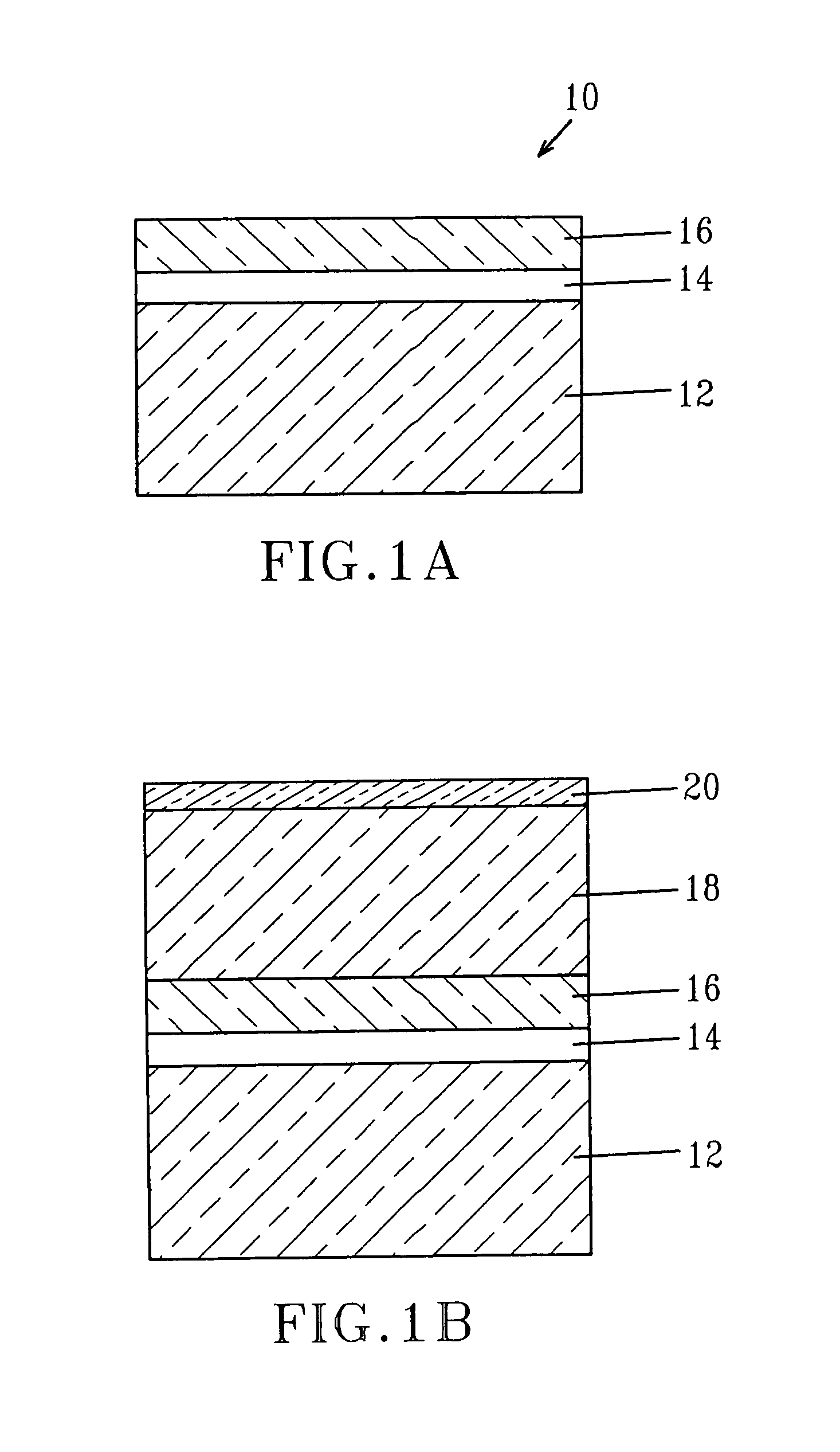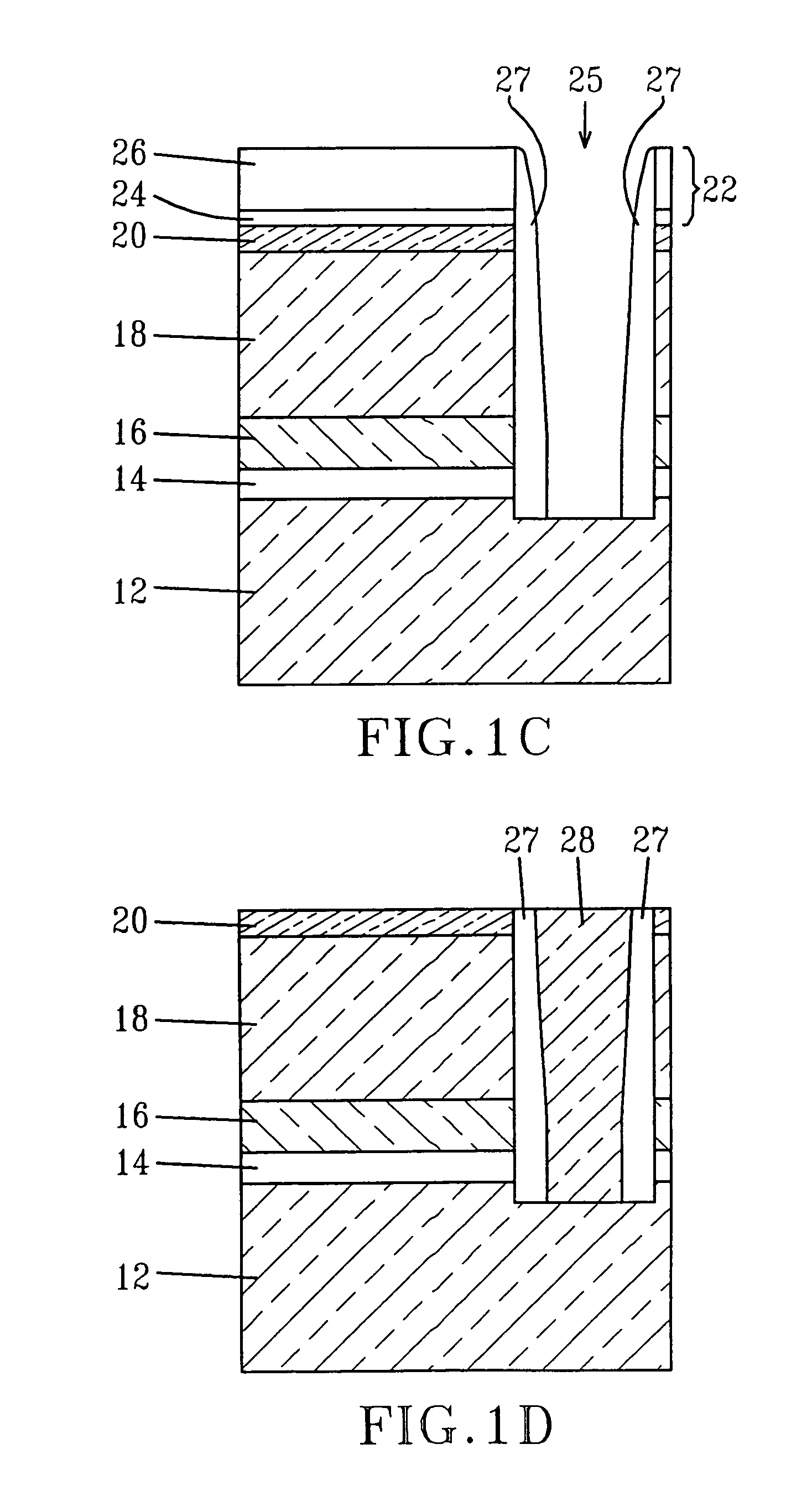Strained silicon CMOS on hybrid crystal orientations
a hybrid crystal orientation and silicon cmos technology, applied in the direction of transistors, semiconductor devices, electrical equipment, etc., can solve the problems of significant deformation of the electron mobility of (110) si surfaces, undesirable width of pfets, and inability to adapt to nfet devices, so as to achieve the effect of improving the performance of each type of devi
- Summary
- Abstract
- Description
- Claims
- Application Information
AI Technical Summary
Benefits of technology
Problems solved by technology
Method used
Image
Examples
first embodiment
[0042]Referring to FIG. 1A, there is shown the hybrid substrate 10 that is employed in the present invention. The hybrid substrate 10 comprises a first semiconducting layer 12, a buried insulating layer 14 located on a surface of the first semiconducting layer 12, and a second semiconducting layer 14 located on a surface of the buried insulating layer 14. In accordance with the present invention, the first semiconducting layer 12 of the hybrid substrate 10 comprises a first semiconducting material that has a first crystallographic orientation and the second semiconducting layer 16 of the hybrid substrate 10 comprises a second semiconducting material that has a second crystallographic orientation which differs from the first crystallographic orientation.
[0043]The first semiconducting layer 12 of the hybrid substrate 10 is comprised of any semiconducting material including, for example, Si, SiC, SiGe, SiGeC, Ge, GaAs, InAs, InP as well as other III / V or II / VI compound semiconductors. ...
third embodiment
[0081]the present invention is slightly different from the first two embodiments mentioned above in that the process flow begins with first providing the structure shown in FIG. 3A which includes a first semiconducting layer 12 in the form of a relaxed SiGe alloy layer formed directly on a surface of a handle wafer 100. The handle wafer comprises any semiconducting or non-semiconducting substrate and the first semiconducting layer 12 is formed by a deposition process.
[0082]Next, the structure shown in FIG. 3A is bonded to a structure that includes a buried insulating layer 14 and a second semiconducting layer 16 so as to provide the structure shown in FIG. 3B.
[0083]A patterned hard mask layer 22 comprising oxide layer 24 and nitride layer 26 is then formed as described above and thereafter an opening that extends down to the relaxed SiGe alloy layer, i.e., first semiconducting layer 12, is formed through the patterned hard mask layer 22. A regrown semiconducting material 28 comprisi...
fifth embodiment
[0095]the present invention is shown in FIGS. 5A–E. Unlike the previous embodiments described above, the final strained Si-containing hybrid substrate shown in FIG. 5E has device regions that are both SOI like since buried insulating layers are present beneath the regrown semiconductor material 28 and the second semiconductor layer 16. FIG. 5A shows the initial structure of this embodiment of the present invention. Specifically, the initial structure shown in FIG. 5A includes a handle wafer 100, bottom insulating layer 102, first sacrificial semiconducting layer 12′ and SiGe alloy layer 50. The handle wafer 100 may include any semiconductor or non-semiconductor substrate well known in the art. Bottom insulating layer 102 is comprised of one of the insulators mentioned above in regard to buried insulating layer 14. The SiGe alloy layer 50 is formed as described above and that layer typically has a thickness of about 100 nm or less.
[0096]After providing the structure shown in FIG. 5A,...
PUM
| Property | Measurement | Unit |
|---|---|---|
| thickness | aaaaa | aaaaa |
| thickness | aaaaa | aaaaa |
| thickness | aaaaa | aaaaa |
Abstract
Description
Claims
Application Information
 Login to View More
Login to View More - R&D
- Intellectual Property
- Life Sciences
- Materials
- Tech Scout
- Unparalleled Data Quality
- Higher Quality Content
- 60% Fewer Hallucinations
Browse by: Latest US Patents, China's latest patents, Technical Efficacy Thesaurus, Application Domain, Technology Topic, Popular Technical Reports.
© 2025 PatSnap. All rights reserved.Legal|Privacy policy|Modern Slavery Act Transparency Statement|Sitemap|About US| Contact US: help@patsnap.com



